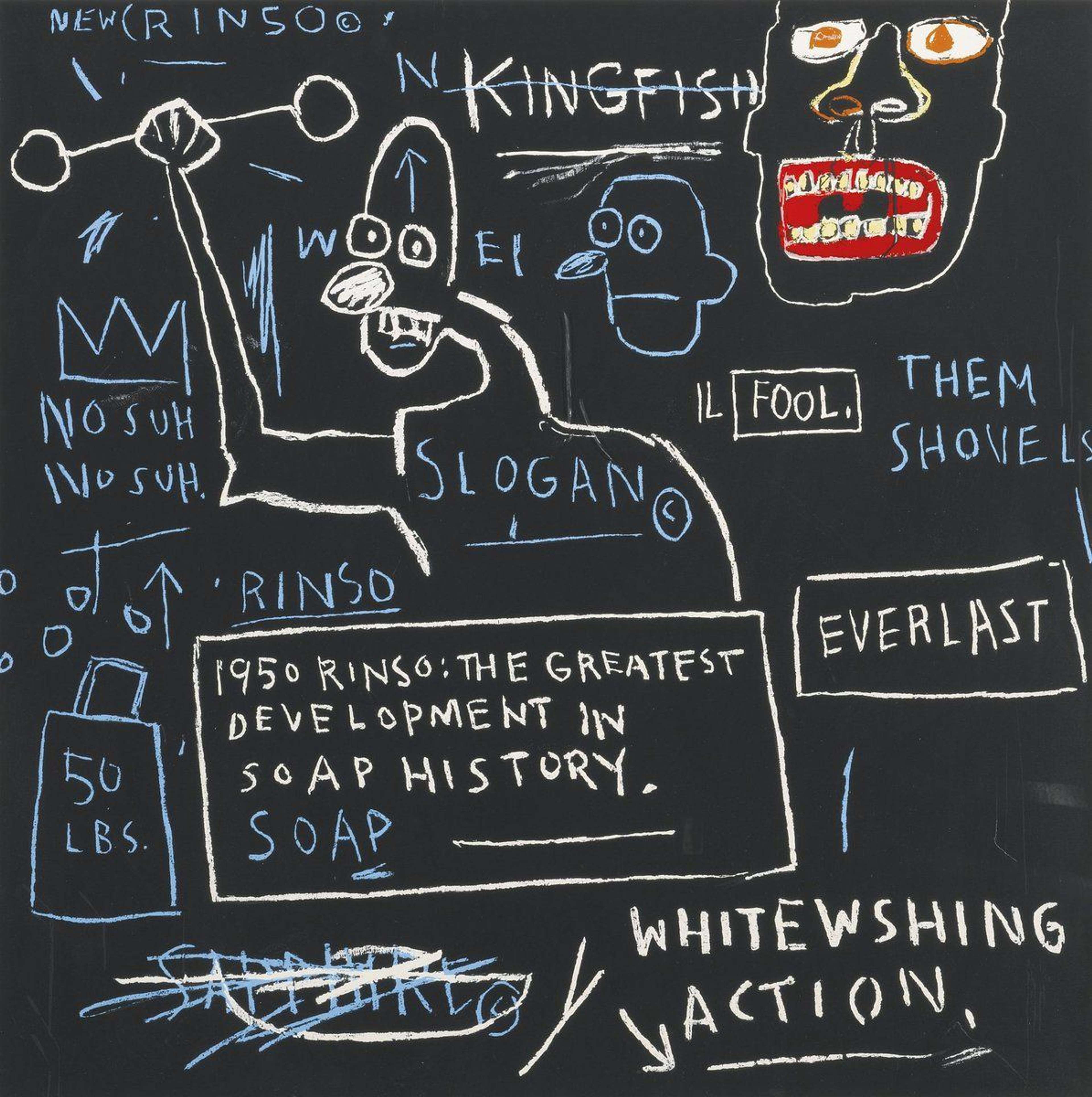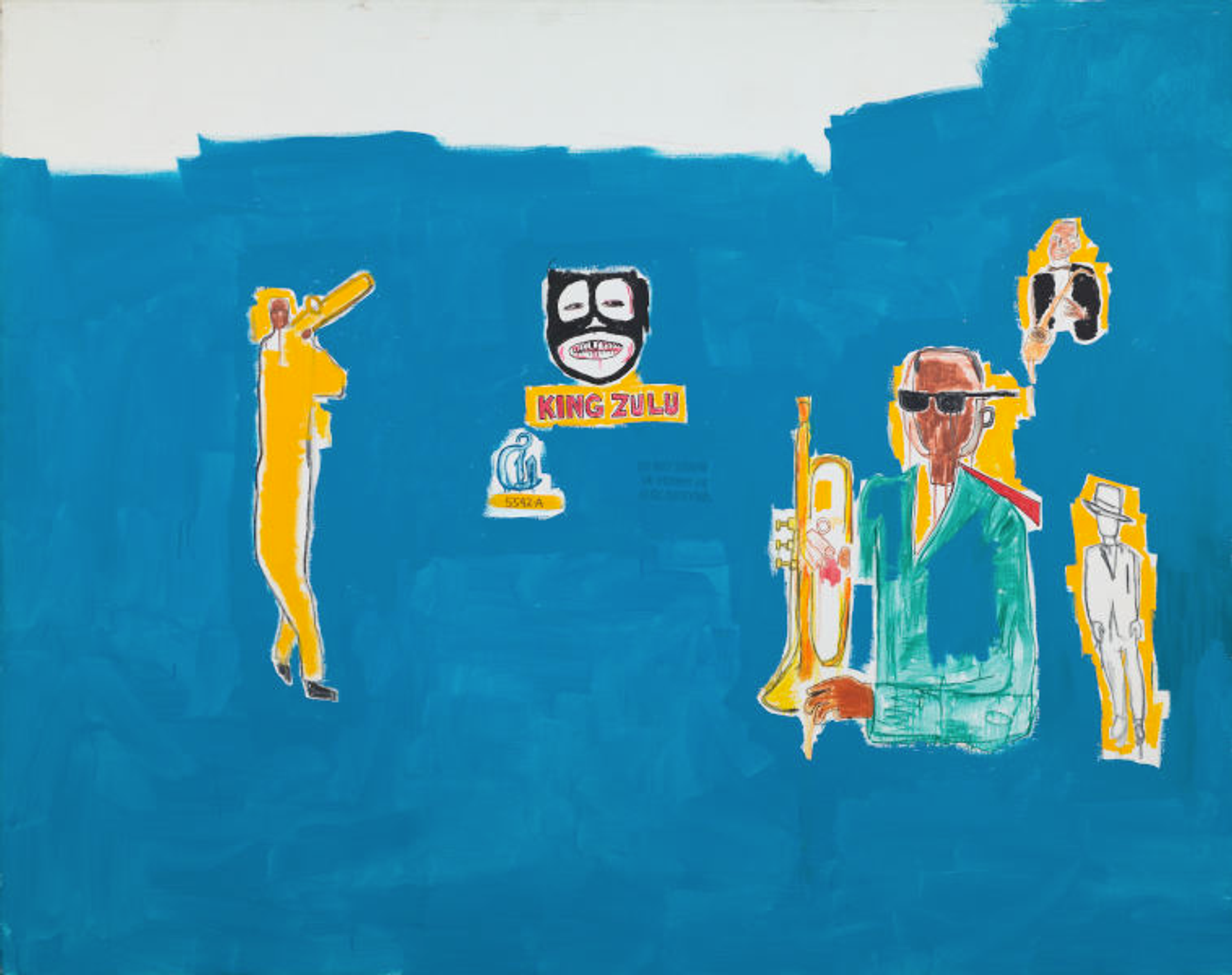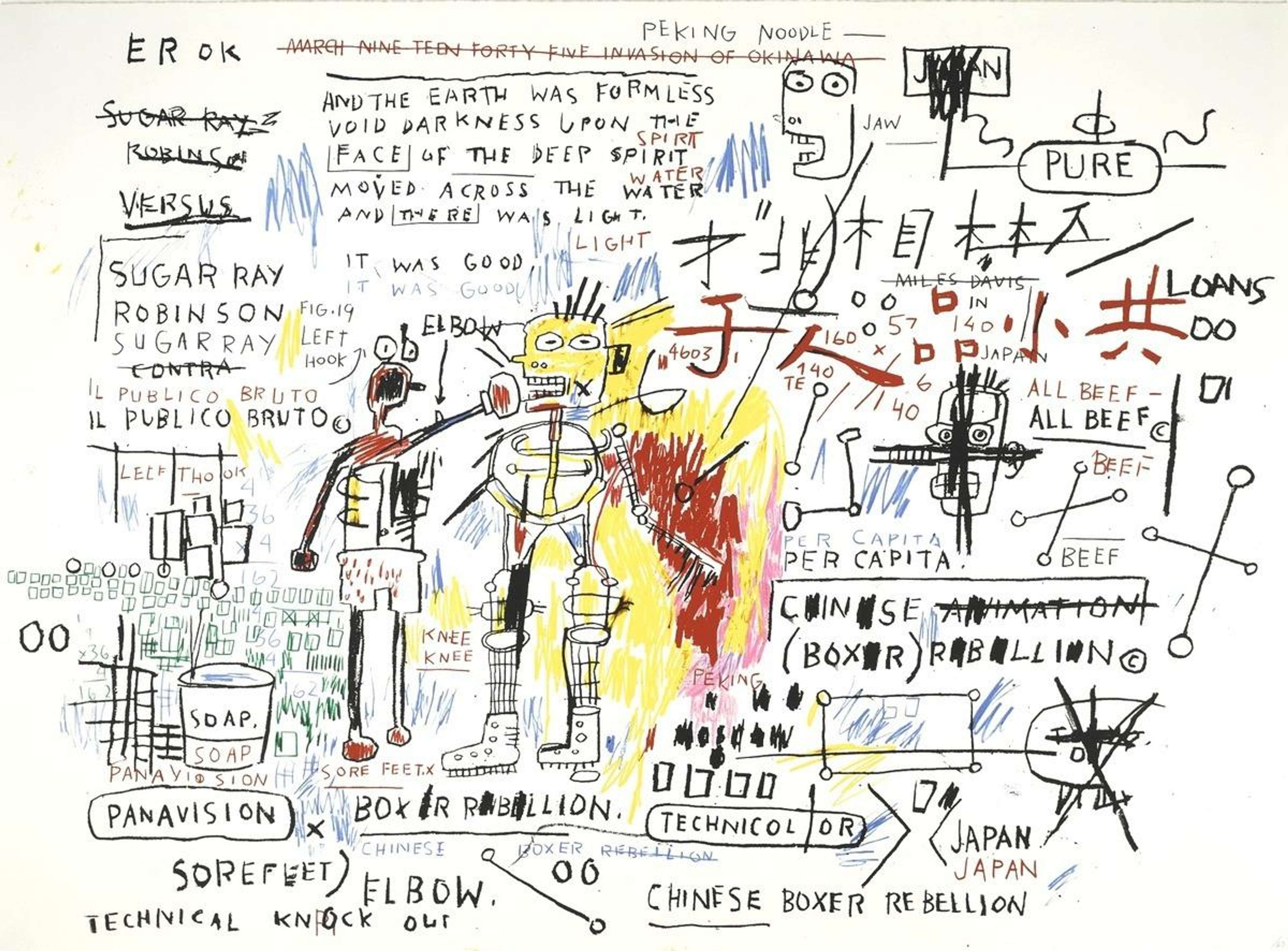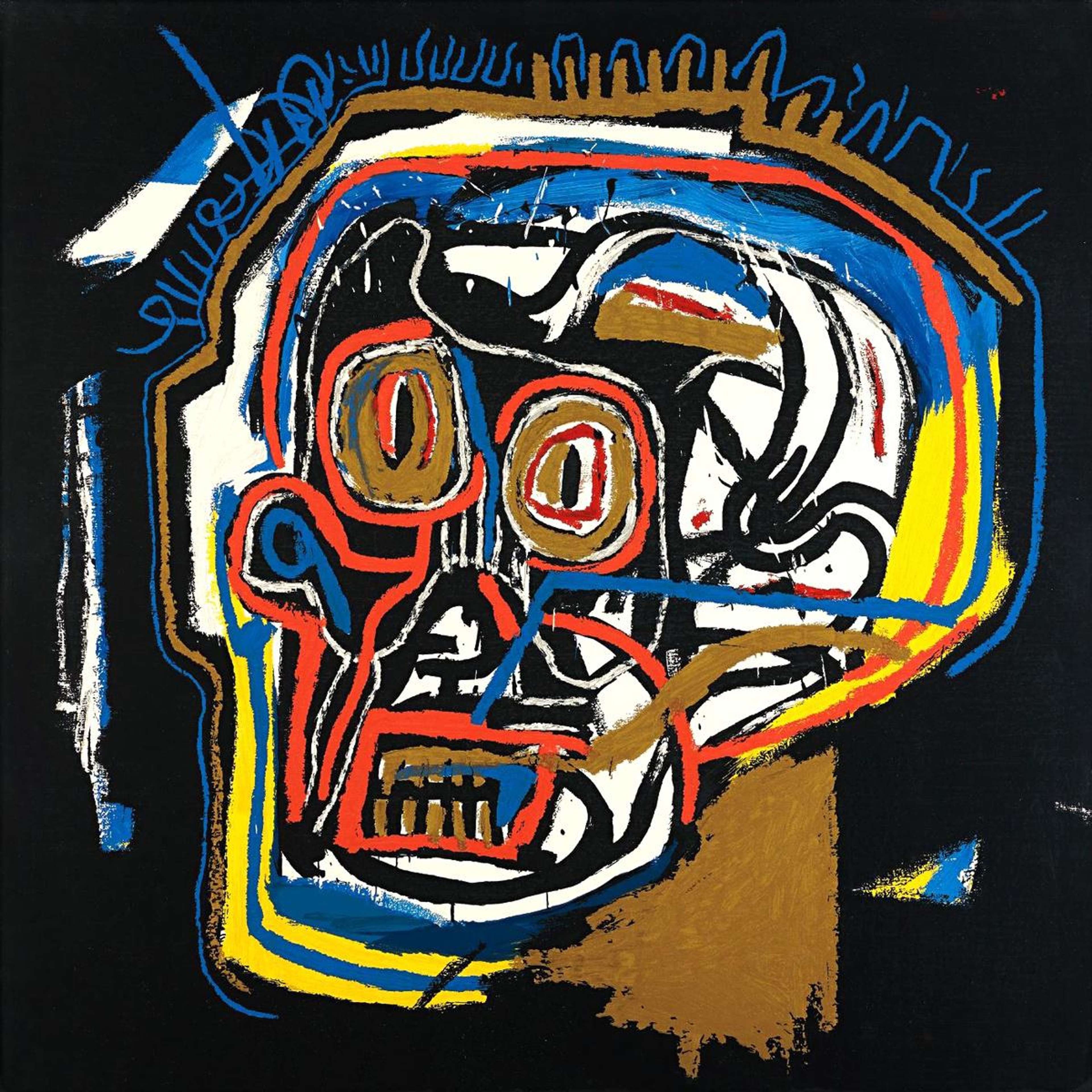Championing Black Creators
 Jawbone Of An Ass © Jean-Michel Basquiat 2004
Jawbone Of An Ass © Jean-Michel Basquiat 2004
Interested in buying or selling
Jean-Michel Basquiat?

Jean-Michel Basquiat
57 works
Jean-Michel Basquiat, a prodigious figure of the late 20th-century art scene, fundamentally altered the landscape of contemporary art.With his raw, evocative imagery and graffiti-inspired scrawls, he didn't merely challenge conventional artistic norms; he dismantled them. Rising from New York City, Basquiat became emblematic of a new wave of artists who sought to break boundaries and defy traditionalist perceptions. Basquiat’s oeuvre served not only as avant-garde masterpieces but also as powerful platforms that elevated Black voices in an art market that had long overlooked them. Through his work, Basquiat beckoned a shift, championing the voices that demanded recognition and reverence.
Basquiat's Early Life and Introduction to Art
Basquiat's Early Life and Introduction to Art
Jean-Michel Basquiat was born in Brooklyn, New York, in 1960, a melting pot of cultures and creative energies. From a young age, he exhibited a keen interest in art. Encouraged by his mother, Basquiat developed an early appreciation for visual storytelling. This early exposure deeply enriched his perspective, leading to a unique fusion of cultural motifs and themes in his work.
In the late 1970s, Basquiat started as a graffiti artist in Lower Manhattan under the pseudonym SAMO. His graffiti, though cryptic, was often tinged with biting social commentary. By the late 70s and early 80s, he transitioned from spraying on street walls to painting on canvases. However, the art world, dominated by traditional and predominantly white galleries, was initially hesitant to recognise his raw, unorthodox style. It was a challenging period for Basquiat, who grappled with racial stereotypes while seeking acknowledgment for his work's intrinsic value. Despite these challenges, his formidable compositions ensured that he wouldn't remain unnoticed for long.
Basquiat's Visual Response for Racial Identity and Injustice
Decoding Symbols and Narratives
Basquiat's art is rich in symbolism. One of his most recurrent symbols is the crown, which he often placed atop figures in his paintings. At a glance, the crown might be interpreted as a sign of royalty or superiority. However, considering the context of Basquiat's work, it holds deeper implications. The crown, when placed on Black figures, could be seen as a reclamation of dignity and worth in a society that frequently devalued Black lives. It championed the notion that Black identity was regal, significant, and deserving of respect.
Graffiti, often associated with urban decay and lower socioeconomic status, was elevated to high art through Basquiat's work, challenging established notions of what art should look like and where it belongs.
Throughout his oeuvre, Basquiat often paid homage to Black historical figures, musicians, and athletes. These personalities, like Charlie Parker and Joe Louis, represented strength, resilience, and genius in their respective fields. By integrating them into his artwork, Basquiat challenged the art world's (and society's) selective memory. His paintings served as reminders of the contributions of Black individuals that were often overshadowed or deliberately ignored.
Confronting Systemic Racism and Marginalisation
Basquiat's works are a vivid reflection of the racial tensions and societal contradictions of his era. Pieces like Irony Of A Negro Policeman confront the paradoxes inherent in Black individuals navigating white-dominated structures. The very title suggests the irony of a Black man embodying a role that historically oppressed his community. Through such works, Basquiat highlighted the intricate dance between conformity and resistance that Black individuals had to perform daily.
How Did Basquiat Combine Art and Activism?
Whether it was the blatant commodification of Black culture, police brutality, or the struggles of marginalised groups, Basquiat's works were fearless in their portrayal of societal ills. His canvases were battlefields where he wrestled with complex themes, with each brushstroke a testament to his commitment to justice and representation.
The Daros Suite, a series of 32 drawings, stands as a potent example of Basquiat's dedication to elevating overlooked Black narratives. This series, with its raw intensity and unapologetic focus on Black experiences, is a masterclass in merging art with activism. Boxer Rebellion specifically addresses a duality of themes in its portrayal. While the title directly references the historic Chinese uprising, it also subtly nods to Basquiat’s boxing heroes, figures of pride and resistance against injustice. This dual narrative showcases Basquiat’s skill in weaving complex stories and emphasises his deep engagement with themes of rebellion and identity.
Basquiat's Influence on the Representation of Black Creators
In the expanse of the art world, where Eurocentric visions often dominated the canon, Basquiat's very existence and prominence challenged pre-existing norms. His art served as a fierce counter-narrative to the stories that the art world told itself.
Spotlighting the Undiscovered Genius
The term undiscovered genius frequently finds its way into discussions about artists of colour, especially Black artists. The label, albeit meant to be complimentary, insinuates that such talents are rarities, anomalies amidst their racial or ethnic backgrounds. Jean-Michel Basquiat, with his meteoric rise, was often boxed into this narrative. But instead of passively accepting this mantle, he actively used his platform to spotlight many 'undiscovered' talents.
Basquiat's Undiscovered Genius from the Daros Suite series confronts art world biases, depicting an anonymous Black musician. Central to the piece is the term 'GRIOT BLUESMAN'. The 'griot', a West African storyteller, has roots influencing American blues. By connecting 'griot' to 'bluesman', Basquiat underscores blues' African origins and the richness of Black musical heritage. The artwork references the Mississippi Delta and contrasts the musician with the text '“VERSUS” THE DEVIL ⓒ’, challenging derogatory labels attached to blues as 'the Devil’s music', spotlighting the genre's profound historical and cultural significance.
 Image © British Vogue / Lenny Kravitz with his Basquiat © François Halard 2019Image © British Vogue / Lenny Kravitz with his Basquiat © François Halard 2019
Image © British Vogue / Lenny Kravitz with his Basquiat © François Halard 2019Image © British Vogue / Lenny Kravitz with his Basquiat © François Halard 2019Shifting the Art World's Perspectives
Before Basquiat, the art world was somewhat monolithic, with limited representation of diverse voices, especially Black artists. His emergence disrupted this status quo, presenting raw, unfiltered narratives of Black identity, culture, and socio-political challenges. This laid the groundwork for a more inclusive art world, encouraging the rise of new voices that offered fresh perspectives. Museums, galleries, and collectors gradually expanded their horizons, seeking art that reflected the world's rich tapestry of experiences and stories. As barriers started to erode, artists from various backgrounds found their footing, reshaping the art world's landscape with innovative approaches and themes. This evolution signifies not just a change in artistic tastes but a broader cultural shift, highlighting the imperative for diverse representation in every facet of society.
Many of today’s top cultural influencers and entertainers reference Basquiat not only in their medium of choice but also proudly showcase his work in their personal art collections. The prominence of Basquiat in popular culture—from music lyrics to fashion collaborations—further illustrates his influence. These acknowledgments, from varied spheres of influence, not only celebrate Basquiat's genius but also underscore the importance of recognising and championing diverse voices in the arts and beyond.
Is Basquiat a good investment?
Few blue-chip artists have seen their works ascend the financial ladder as swiftly as Jean-Michel Basquiat. From his initial street art collaborations with Al Diaz to Painting Four Hands with Andy Warhol and his more recent exhibition King Pleasure, the value of Basquiat’s art has witnessed astronomical appreciation.
In recent years, Basquiat’s works have dominated auction headlines. His Untitled, 1982, portraying a large Neo-Expressionist style skull, was auctioned for a staggering $110.5 million in 2017, marking it as one of the highest sums ever paid for an American artist's work. Such record-breaking sales have solidified Basquiat's position in the upper echelons of the art investment market.
Their scarcity, combined with increasing demand from both private collectors and institutions, has driven prices in the Basquiat market upwards. In 2023, among Basquiat’s top prints were pieces from the Daros Suite, Flexible, Cabeza, and Charles The First. Additionally, the global recognition of Basquiat's contribution to art and culture has cemented his works as not only artistically but also financially invaluable.
The Legacy of Basquiat: Opening Doors for Change
Championing Black Talents: From Galleries to Digital Platforms
In the aftermath of Basquiat's meteoric rise, the global art world has undergone significant transformation and introspection. Within the US, institutions like the Studio Museum in Harlem have emerged as vital champions for artists of African descent. In London, Addis Fine Art stands out as a pioneering gallery, spotlighting talent from Ethiopia, the Horn of Africa, and their respective diasporas. Meanwhile, Paris boasts the Mariane Ibrahim Gallery, notable for its diverse array of artists but also for their individual success. Among them, Amoako Boafo stands out, having fetched over $3.4 million in auction sales.
Nonprofit entities, such as ARTNOIR, play a pivotal role in democratising the art sphere. They are committed to infusing exclusivist spaces with diversity, inclusivity, and vibrancy, while also forging robust connections among future Black and Brown artists, curators, and collectors, fueling mutual growth. On the digital front, Good Black Art emerges as a trailblazer, holding the unique distinction of being the premier platform singularly devoted to showcasing emerging Black artistic talents globally.
1-54 Contemporary African Art Fair, held annually in London, New York, and Marrakech, showcases contemporary art from Africa and its diaspora, providing numerous Black artists with a global platform. This event has evolved into a major focal point for art enthusiasts and collectors around the world, presenting artists with the invaluable opportunity to display their work, bridge cultural divides, and ignite meaningful dialogues.
The New Vanguard: Black Artists Reshaping Art Dialogues
In the period succeeding Basquiat's prominence, a new wave of Black artists began to command attention, signifying more than just a passing trend but a renewed recognition of the depth and diversity of Black artistic expression. Kehinde Wiley, for instance, is celebrated for his grandiose portraits that recontextualize classical European art by placing Black figures at their centre, thereby challenging historical artistic norms and championing Black beauty and power. Rashid Johnson incorporates diverse materials like shea butter and black soap in his work, creating art pieces that are both visually striking and deeply evocative of Black life and experiences. Adam Pendleton employs a variety of mediums, from painting to performance, to dissect and reconstruct notions of Blackness, history, and language. Each of these artists, in their unique ways, resonates with Basquiat's ethos — confronting established narratives, offering fresh perspectives, and redefining what it means to be a Black artist in a constantly evolving creative landscape.
Charting the Path Forward
Basquiat's influence on contemporary culture is undeniable. His work, characterised by its poignant social commentary and vibrant aesthetic, has not only redefined visual storytelling but also set a new precedent for the representation of Black creators. As we move forward, it becomes crucial to not only appreciate but also critically engage with Basquiat's works and the myriad of narratives they encompass













